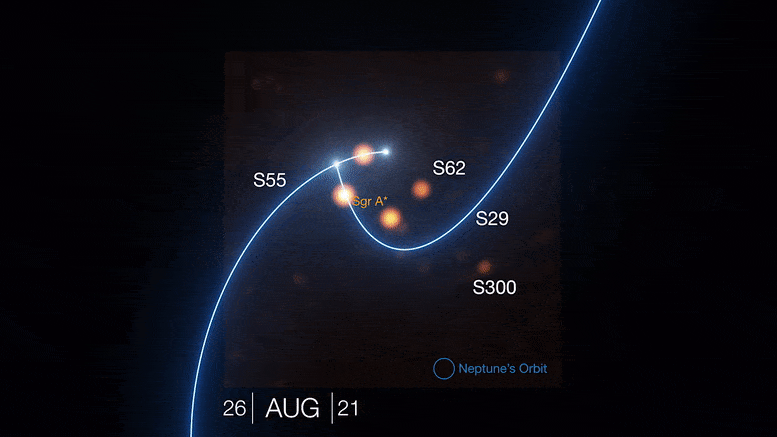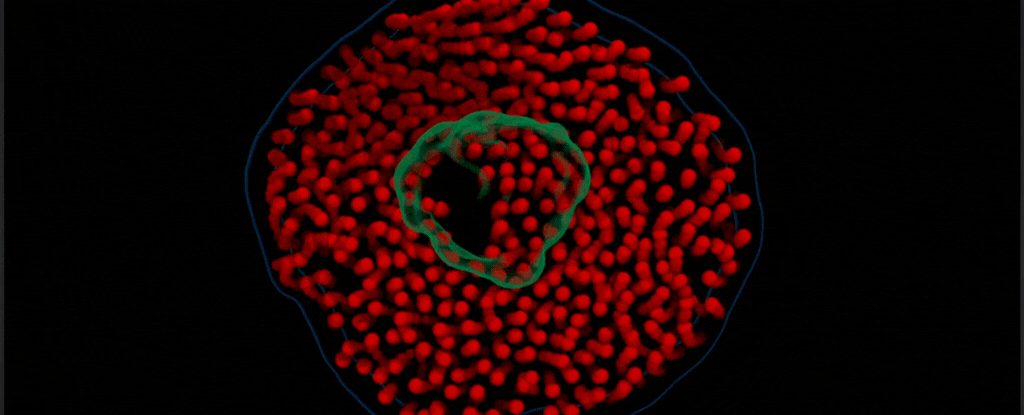
En esta ilustración, se ve a las estrellas orbitando en órbita cercana alrededor del agujero negro supermasivo que se encuentra en el centro de la Vía Láctea, conocido como Sagitario A* (Sgr A*). Crédito: Observatorio Internacional Gemini/NOIRLab/NSF/AURA/J. da Silva/(Spaceengine), Agradecimientos: M. Zamani (NSF’s NOIRLab)[2]Información precisa sobre el agujero negro supermasivo en el corazón de la Vía Láctea
Los astrónomos usan el Observatorio Gemini y un telescopio internacional conjunto para resaltar a Sagitario A*
Obtenida con la ayuda del telescopio Gemini North, los astrónomos han realizado las mediciones más precisas hasta la fecha del movimiento de las estrellas alrededor de la supermasa.[{» attribute=»»>black hole at the center of the Milky Way. These results show that 99.9% of the mass contained at the very center of the galaxy is due to the black hole, and only 0.1% could include stars, smaller black holes, interstellar dust, and gas, or dark matter.
Los astrónomos han medido con mayor precisión que nunca la posición y la velocidad de las cuatro estrellas en las inmediaciones de Sagitario A* (Sgr A*),[1] El agujero negro supermasivo que acecha en el centro de la Vía Láctea. Se ha descubierto que los movimientos de estas estrellas, denominadas S2, S29, S38 y S55, siguen caminos que muestran que la masa en el centro de la Vía Láctea se debe casi en su totalidad a Sgr A * El agujero negro, que deja muy poco espacio para cualquier otra cosa.
El equipo de investigación utilizó una variedad de instalaciones astronómicas avanzadas en esta investigación. Para medir las velocidades de las estrellas, utilizaron la espectroscopia del espectrógrafo de infrarrojo cercano Gemini (GNIRS) en Gemini North, cerca de la cumbre de Maunakea en Hawái, parte del Observatorio Internacional Gemini, el programa NSF NOIRLab y el instrumento SINFONI en el Observatorio Europeo Austral.[{» attribute=»»>تلسكوب كبير جدا. تم استخدام أداة GRAVITY في VLTI لقياس مواضع النجوم.

رسم توضيحي للثقب الأسود القوس A * في وسط مجرة درب التبانة. الائتمان: مرصد الجوزاء الدولي / NOIRLab / NSF / AURA / J. دا سيلفا / (Spaceengine) ، شكر وتقدير: M. Zamani (NSF’s NOIRLab)
قال راينهارد جينزل ، مدير معهد ماكس بلانك للفيزياء خارج كوكب الأرض والمشترك في الحصول على جائزة نوبل في الفيزياء لعام 2020: «نحن ممتنون جدًا لمرصد الجوزاء ، الذي أعطتنا أداة GNIRS الخاصة به المعلومات الهامة التي نحتاجها». «يُظهر هذا البحث التعاون العالمي في أفضل حالاته.»
يحتوي مركز المجرة التابع لمجرة درب التبانة ، الذي يقع على بعد حوالي 27000 سنة ضوئية من الشمس ، على مصدر الراديو المضغوط Sgr A * الذي حدده علماء الفلك على أنه ثقب أسود فائق الكتلة يبلغ 4.3 مليون مرة كتلة الشمس. على الرغم من عقود من الملاحظات المضنية – وتم منح جائزة نوبل لاكتشاف هوية Sgr A *[3] – Ha sido difícil probar de forma definitiva que la mayor parte de esta masa pertenece únicamente al agujero negro supermasivo y no incluye también una gran cantidad de materia como las estrellas, que son más pequeñas. agujeros negroso polvo y gas interestelar, o materia oscura.

Estas imágenes anotadas, adquiridas con el instrumento GRAVITY en el Interferómetro del Telescopio Muy Grande (VLTI) de ESO entre marzo y julio de 2021, muestran estrellas orbitando cerca de Sagitario A*, el agujero negro supermasivo en el corazón de la Vía Láctea. Una de estas estrellas, llamada S29, fue observada cuando se acercaba al agujero negro en su punto más cercano a una distancia de 13 mil millones de kilómetros, 90 veces la distancia entre el Sol y la Tierra. Otra estrella, llamada S300, fue descubierta por primera vez en nuevas observaciones del VLTI informadas por ESO.
Usando Gemini North del Observatorio Internacional Gemini, un programa de NOIRLab de NSF y VLT de ESO, los astrónomos han medido con mayor precisión que nunca la posición y la velocidad de estas estrellas S29 y S55 (así como las estrellas S2 y S38), y encontraron que se estaban moviendo. de una manera que muestra que la masa en el centro de la Vía Láctea se debe casi en su totalidad al agujero negro Sagitario A*, dejando muy poco espacio para cualquier otra cosa. Crédito: Colaboración ESO/GRAVITY
«Con el Premio Nobel de Física 2020 otorgado para confirmar que Sgr A* es de hecho un agujero negro, ahora queremos seguir adelante. Nos gustaría entender si hay algo más escondido en el centro de la Vía Láctea, y si en general la relatividad es de hecho la teoría correcta «La forma más directa de responder a esta pregunta es seguir de cerca las órbitas de las estrellas que pasan cerca de Sgr A*», explicó Stefan Gelsen, uno de los astrónomos involucrados en este trabajo.
La teoría general de la relatividad de Einstein predice que las órbitas de las estrellas alrededor de un objeto supermasivo compacto son ligeramente diferentes de las predichas por la física newtoniana clásica. En particular, la relatividad general predice que las órbitas de las estrellas dibujarán una elegante roseta, un efecto conocido como Schwarzschild proactivo. Para ver realmente las estrellas siguiendo esta rosa, el equipo rastreó la posición y la velocidad de cuatro estrellas en las inmediaciones de Sgr A*, llamadas S2, S29, S38 y S55. Las observaciones del equipo de cuán lejos han llegado estas estrellas permitieron inferir la distribución de masa dentro de Sgr A*. Descubrieron que cualquier masa que se extienda dentro de la órbita de S2 contribuye como máximo con el 0,1% de la masa del agujero negro supermasivo.
secuencia animada para[{» attribute=»»>ESO’s Very Large Telescope Interferometer (VLTI) images of stars around the Milky Way’s central black hole. This animation shows the orbits of the stars S29 and S55 as they move close to Sagittarius A* (center), the supermassive black hole at the heart of the Milky Way. As we follow the stars along in their orbits, we see real images of the region obtained with the GRAVITY instrument on the VLTI in March, May, June and July 2021. In addition to S29 and S55, the images also show two fainter stars, S62 and S300. S300 was detected for the first time in new VLTI observations reported by ESO.
Measuring the minute variations in the orbits of distant stars around our galaxy’s supermassive black hole is incredibly challenging. To make further discoveries, astronomers will have to push the boundaries not only of science but also of engineering. Upcoming extremely large telescopes (ELTs) such as the Giant Magellan Telescope and the Thirty Meter Telescope (both part of the US-ELT Program) will allow astronomers to measure even fainter stars with even greater precision.
“We will improve our sensitivity even further in future, allowing us to track even fainter objects,” concluded Gillessen. “We hope to detect more than we see now, giving us a unique and unambiguous way to measure the rotation of the black hole.”
Acércate al corazón de la Vía Láctea para ver las estrellas observadas por el Very Large Telescope del Observatorio Europeo Austral (última observación de 2019). Un mayor acercamiento revela estrellas más cercanas al agujero negro, observadas utilizando el instrumento GRAVITY en el interferómetro del Very Large Telescope de ESO a mediados de 2021.
“Los observatorios Gemini continúan brindando nuevos conocimientos sobre la naturaleza de nuestra galaxia y el agujero negro supermasivo en su centro”, dijo Martin Steele, Oficial del Programa Gemini en la Fundación Nacional de Ciencias. «Un mayor desarrollo de instrumentos durante la próxima década destinados a un uso generalizado mantendrá el liderazgo de NOIRLab en la caracterización del universo que nos rodea».
Para obtener más información sobre esta investigación, consulte Mira las estrellas correr alrededor del agujero negro supermasivo de la Vía Láctea.
notas
- Sagitario A* se pronuncia «estrella de Sagitario».
- El VLT de ESO consta de cuatro telescopios de sitio único con un diámetro de 8,2 metros que pueden captar luz a través de una red de espejos y túneles subterráneos mediante una técnica conocida como interferometría, para formar el VLTI. GRAVITY utiliza esta tecnología para medir la posición de los objetos del cielo nocturno por altitud[{» attribute=»»>accuracy — equivalent to picking out a quarter-dollar coin on the surface of the Moon.
- The 2020 Nobel Prize in Physics was awarded in part to Reinhard Genzel and Andrea Ghez “for the discovery of a supermassive compact object at the center of our galaxy.”
This research is presented in the paper “The mass distribution in the Galactic Centre from interferometric astrometry of multiple stellar orbits” which is published in Astronomy & Astrophysics. A companion paper “Deep Images of the Galactic Center with GRAVITY” has also been published in Astronomy & Astrophysics.
References:
“Mass distribution in the Galactic Center based on interferometric astrometry of multiple stellar orbits” by GRAVITY Collaboration: R. Abuter, N. Aimar, A. Amorim, J. Ball, M. Bauböck, J. P. Berger, H. Bonnet, G. Bourdarot, W. Brandner, V. Cardoso, Y. Clénet, Y. Dallilar, R. Davies, P. T. de Zeeuw, J. Dexter, A. Drescher, F. Eisenhauer, N. M. Förster Schreiber, A. Foschi, P. Garcia, F. Gao, E. Gendron, R. Genzel, S. Gillessen, M. Habibi, X. Haubois, G. Heißel,??, T. Henning, S. Hippler, M. Horrobin, L. Jochum, L. Jocou, A. Kaufer, P. Kervella, S. Lacour, V. Lapeyrère, J.-B. Le Bouquin, P. Léna, D. Lutz, T. Ott, T. Paumard, K. Perraut, G. Perrin, O. Pfuhl, S. Rabien, J. Shangguan, T. Shimizu, S. Scheithauer, J. Stadler, A.W. Stephens, O. Straub, C. Straubmeier, E. Sturm, L. J. Tacconi, K. R. W. Tristram, F. Vincent, S. von Fellenberg, F. Widmann, E. Wieprecht, E. Wiezorrek, J. Woillez, S. Yazici and A. Young, 19 January 2022, Astronomy & Astrophysics.
DOI: 10.1051/0004-6361/202142465
“Deep images of the Galactic center with GRAVITY” by GRAVITY Collaboration: R. Abuter, N. Aimar, A. Amorim, P. Arras, M. Bauböck, J. P. Berger, H. Bonnet, W. Brandner, G. Bourdarot, V. Cardoso, Y. Clénet, R. Davies, P. T. de Zeeuw, J. Dexter, Y. Dallilar, A. Drescher, F. Eisenhauer, T. Enßlin, N. M. Förster Schreiber, P. Garcia, F. Gao, E. Gendron, R. Genzel, S. Gillessen, M. Habibi, X. Haubois, G. Heißel, T. Henning, S. Hippler, M. Horrobin, A. Jiménez-Rosales, L. Jochum, L. Jocou, A. Kaufer, P. Kervella, S. Lacour, V. Lapeyrère, J.-B. Le Bouquin, P. Léna, D. Lutz, F. Mang, M. Nowak, T. Ott, T. Paumard, K. Perraut, G. Perrin, O. Pfuhl, S. Rabien, J. Shangguan, T. Shimizu, S. Scheithauer, J. Stadler, O. Straub, C. Straubmeier, E. Sturm, L. J. Tacconi, K. R. W. Tristram, F. Vincent, S. von Fellenberg, I. Waisberg, F. Widmann, E. Wieprecht, E. Wiezorrek, J. Woillez, S. Yazici, A. Young and G. Zins, 19 January 2022, Astronomy & Astrophysics.
DOI: 10.1051/0004-6361/202142459
More information
The team behind this result is composed of The GRAVITY Collaboration, R. Abuter (European Southern Observatory), A. Amorim (Universidade de Lisboa and CENTRA – Centro de Astrofísica e Gravitação), M. Bauböck (Max Planck Institute for Extraterrestrial Physics and University of Illinois), J. P. Berger (University Grenoble Alpes and European Southern Observatory), H. Bonnet (European Southern Observatory), G. Bourdarot (University Grenoble Alpes and Max Planck Institute for Extraterrestrial Physics), V. Cardoso (CENTRA – Centro de Astrofísica e Gravitação and CERN), Y. Clénet (LESIA, Observatoire de Paris), Y. Dallilar (Max Planck Institute for Extraterrestrial Physics), R. Davies (Max Planck Institute for Extraterrestrial Physics), P. T. de Zeeuw (Leiden University and Max Planck Institute for Extraterrestrial Physics), J. Dexter (University of Colorado, Boulder), A. Drescher (Max Planck Institute for Extraterrestrial Physics), A. Eckart (University of Cologne and Max Planck Institute for Radio Astronomy), F. Eisenhauer (Max Planck Institute for Extraterrestrial Physics), N. M. Förster Schreiber (Max Planck Institute for Extraterrestrial Physics), P. Garcia (Universidade do Porto and CENTRA – Centro de Astrofísica e Gravitação), F. Gao (Universität Hamburg and Max Planck Institute for Extraterrestrial Physics), E. Gendron (LESIA, Observatoire de Paris), R. Genzel (Max Planck Institute for Extraterrestrial Physics and University of California, Berkeley), S. Gillessen (Max Planck Institute for Extraterrestrial Physics), M. Habibi (Max Planck Institute for Extraterrestrial Physics), X. Haubois (European Southern Observatory), G. Heißel (LESIA, Observatoire de Paris), T. Henning (Max Planck Institute for Astronomy), S. Hippler (Max Planck Institute for Astronomy), M. Horrobin (University of Cologne), L. Jochum (European Southern Observatory), L. Jocou (University Grenoble Alpes), A. Kaufer (European Southern Observatory), P. Kervella (LESIA, Observatoire de Paris), S. Lacour (LESIA, Observatoire de Paris), V. Lapeyrère (LESIA, Observatoire de Paris), J.-B. Le Bouquin (University Grenoble Alpes), P. Léna (LESIA, Observatoire de Paris), D. Lutz (Max Planck Institute for Extraterrestrial Physics), T. Ott (Max Planck Institute for Extraterrestrial Physics), T. Paumard (LESIA, Observatoire de Paris), K. Perraut (University Grenoble Alpes), G. Perrin (LESIA, Observatoire de Paris), O. Pfuhl (European Southern Observatory and Max Planck Institute for Extraterrestrial Physics), S. Rabien (Max Planck Institute for Extraterrestrial Physics), G. Rodríguez-Coira (LESIA, Observatoire de Paris), J. Shangguan (Max Planck Institute for Extraterrestrial Physics), T. Shimizu (Max Planck Institute for Extraterrestrial Physics), S. Scheithauer (Max Planck Institute for Astronomy), J. Stadler (Max Planck Institute for Extraterrestrial Physics), O. Straub (Max Planck Institute for Extraterrestrial Physics), C. Straubmeier (University of Cologne), E. Sturm (Max Planck Institute for Extraterrestrial Physics), L. J. Tacconi (Max Planck Institute for Extraterrestrial Physics), K. R. W. Tristram (European Southern Observatory), F. Vincent (LESIA, Observatoire de Paris), S. von Fellenberg (Max Planck Institute for Extraterrestrial Physics), F. Widmann (Max Planck Institute for Extraterrestrial Physics), E. Wieprecht (Max Planck Institute for Extraterrestrial Physics), E. Wiezorrek (Max Planck Institute for Extraterrestrial Physics), J. Woillez (European Southern Observatory), S. Yazici (Max Planck Institute for Extraterrestrial Physics and the University of Cologne), and A. Young (Max Planck Institute for Extraterrestrial Physics).

. «Aficionado a la música devoto. Adicto al café. Amante de Twitter. Pensador sutilmente encantador. Introvertido sin disculpas».





More Stories
Por primera vez, los científicos capturan en vídeo la danza de las proteínas y las grasas: ScienceAlert
Misión Starlink el martes desde Cabo Cañaveral
El cáncer puede surgir sin mutaciones genéticas